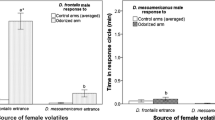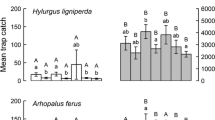Abstract
Chemically mediated behavioral interactions among four species of Scolytidae cohabitingPinus taeda in east Texas appear to be significant in delineating breeding areas within trees and in influencing the sequence of colonization.Dendroctonus frontalis usually arrived first and was not attracted to logs occupied by any of the threeIps species (I. avulsus, I. calligraphus, andI. grandicollis). The response ofI. avulsus to conspecific males was enhanced by the simultaneous presence of actively boring maleI. grandicollis. The response ofIps calligraphus was inhibited in areas whereI. avulsus was also present, but, in turn,I. calligraphus inhibited the response ofI. grandicollis and attractedI. avulsus. Ips grandicollis was strongly inhibited by the simultaneous presence of femaleD. frontalis or maleI. calligraphus, and in turn, maleI. grandicollis inhibitedD. frontalis. The result of this highly interactive olfactory system is that host trees are colonized very rapidly and that, in the process, disadvantageous reproductive interactions are minimized.
Similar content being viewed by others
References
Bedard, W.D., andBrowne, L.E. 1969. A delivery-trapping system for evaluating insect chemical attractants in nature.J. Econ. Entomol. 62:1202–1203.
Bedard, W.D., andWood, D.L. 1974. Programs utilizing pheromones in survey or control. Bark beetles—the western pine beetle, pp. 441–449,in M.C. Birch (ed.). Pheromones. North-Holland, Amsterdam.
Birch, M.C. 1978. Chemical communication in pine bark beetles.Am. Sci, 66:409–419.
Birch, M.C., andŠvihra, P. 1979. Exploiting olfactory interactions between species of Scolytidae, pp. 135–138,in Current Topics in Forest Entomology. W.E. Waters (ed.). Selected Papers from the XVth International Congress of Entomology, Washington, D.C. August 1976. U.S.D.A. Forest Service.
Birch, M.C., andWood, D.L. 1975. Mutual inhibition of the attractant pheromone response by two species ofIps (Coleoptera: Scolytidae).J. Chem. Ecol. 1:101–113.
Byers, J., andWood, D.L. 1980. Interspecific inhibition of the bark beetles,Dendroctonus brevicomis andIps paraconfusus, to their pheromones in the field.J. Chem. Ecol. 6:149–164.
Camors, F.B., Jr., andPayne, T.L. 1972. Response ofHeydenia unica (Hymenoptera: Pteromalidae) toDendroctonus frontalis (Coleoptera: Scolytidae) pheromones and a hosttree terpene.Ann. Entomol. Soc. Am. 65:31–33.
Camors, F.B., Jr., andPayne, T.L. 1973. Sequence of arrival of entomophagons insects to trees infested with the southern pine beetle.Environ. Entomol. 2:267–270.
Coster, J.E., Payne, T.L., Hart, E.R., andEdson, L.J. 1977. Aggregation of the southern pine beetle in response to attractive host trees.Environ. Entomol. 6:725–731.
Hedden, R., Vité, J.P., andMori, K. 1976. Synergistic effect of a pheromone and a kairomone on host selection and colonization byIps avulsus.Nature 261:696–697.
Kinzer, G.W., Fentiman, A.F., Page, T.F., Foltz, R.L., VitÉ, J.P., andPitman, G.B. 1969. Bark beetle attractants: Identification, synthesis and field bioassay of a new compound isolated fromDendroctonus.Nature 221:477–478.
Lanier, G.N., andWood, D.L. 1975. Specificity of response to pheromones in the genusIps (Coleoptera: Scolytidae).J. Chem. Ecol. 1:9–23.
Paine, T.D.,Birch, M.C., andSvihra, P. 1980. Niche breadth and resource partitioning by four sympatric species of bark beetles (Coleoptera: Scolytidae).Oecologia. Submitted.
Payne, T.L., Coster, J.E., Richerson, J.V., Edson, L.J., andHart, E.R. 1978. Field response of the southern pine beetle to behavioral chemicals.Environ. Entomol. 7:578–582.
Richerson, J. V., andPayne, T.L. 1979. Effects of bark beetle inhibitors on landing and attack behavior of the southern pine beetle and beetle associates.Environ. Entomol. 8:360–364.
Stephen, F.M., andDahlsten, D.L. 1976. The arrival sequence of the arthropod complex following attack byDendroctonus brevicomis (Coleoptera: Scolytidae) in ponderosa pine.Can. Entomol. 108:283–304.
Švihra, P.,Birch, M.C., andPaine, T.D. 1980. Within-tree distribution and sequence of attack of four sympatric bark beetle species.Ecol. Entomol. Submitted.
Vité, J.P., andFrancke, W. 1976. The aggregation pheromones of bark beetles: progress and problems.Naturwissenschaften. 63:550–555.
Vité, J.P., andWilliamson, D.L. 1970.Thanasimus dubius: Prey perception.J. Insect. Physiol. 16:233–239.
Vité, J.P., Gara, R.I., andvon Scheller, H.D. 1964. Field observations on the response to attractants of bark beetles infesting southern pines.Contrib. Boyce Thompson Inst. 22:461–470.
Vité, J.P., Ohloff, G., andBillings, R.F. 1978. Pheromonal chirality and integrity of aggregation response in southern species of the bark beetleIps sp.Nature 272:817–818.
Werner, R.A. 1972. Response of the beetle,Ips grandicollis, to combinations of host and insect produced attractants.J. Insect Physiol. 18:1403–1412.
Wood, D.L. 1970. Pheromones of bark beetles, pp. 301–316.in D.L. Wood, R.M. Silverstein, and M. Nakajima, (eds.). Control of Insect Behavior by Natural Products. Academic Press, New York.
Author information
Authors and Affiliations
Rights and permissions
About this article
Cite this article
Birch, M.C., Svihra, P., Paine, T.D. et al. Influence of chemically mediated behavior on host tree colonization by four cohabiting species of bark beetles. J Chem Ecol 6, 395–414 (1980). https://doi.org/10.1007/BF01402917
Received:
Revised:
Issue Date:
DOI: https://doi.org/10.1007/BF01402917




